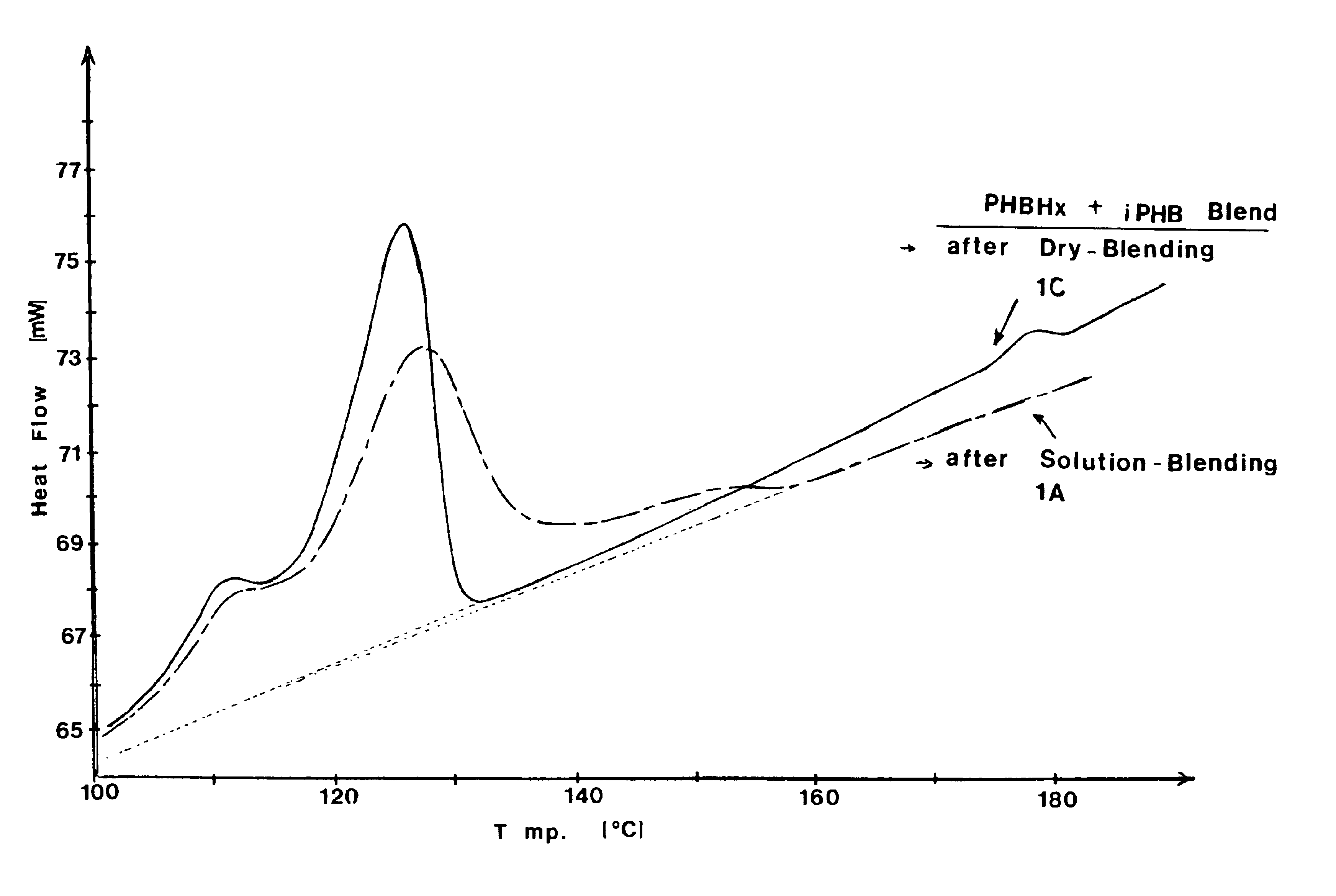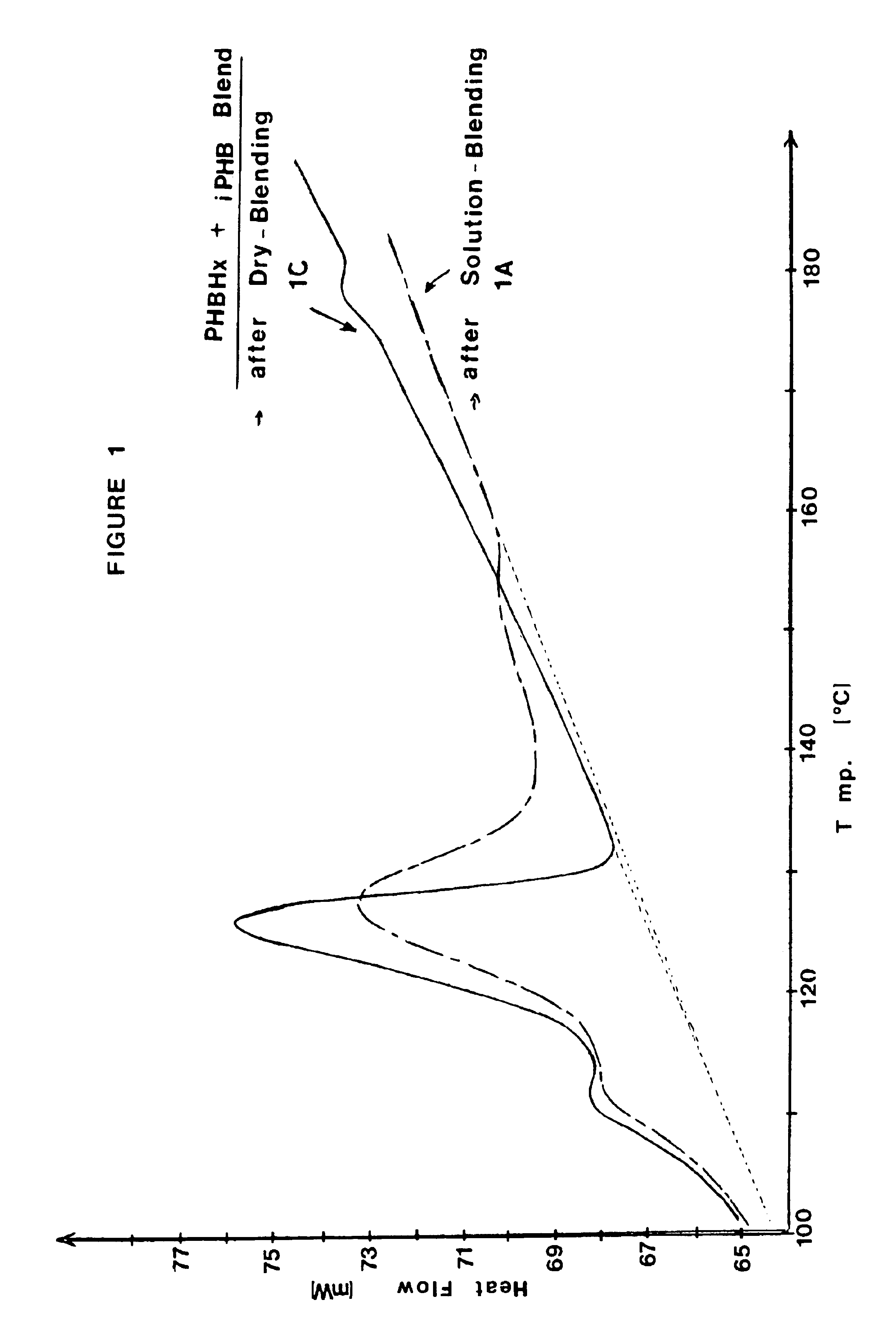Method for making biodegradable polyhydroxyalkanoate copolymers having improved crystallization properties
a technology of polyhydroxyalkanoate and crystallization rate, which is applied in the direction of electrical/magnetic/electromagnetic heating, electric heating, electrical equipment, etc., can solve the problems of inability to dispose of current plastics typically used in making such sanitary garments, inability to provide flexibility, toughness and moisture resistance of plastic films, and more voluminous storage. , to achieve the effect of process method, improving the crystallization rate of semi-
- Summary
- Abstract
- Description
- Claims
- Application Information
AI Technical Summary
Benefits of technology
Problems solved by technology
Method used
Image
Examples
example 1
The present example demonstrates solution blended compositions and methods of the invention. The compositions comprise first and second PHA components. The first PHA component is a copolymer of 3-hydroxybutyrate (RRMU of formula (I) wherein R2 is CH3 and n=1) and about 6.1 mole percent 3-hydroxyhexanoate (RRMU of formula (II) wherein R2 is C3), abbreviated as PHBHx copolymer. The second PHA component is isotactic polyhydroxybutyrate (i-PHB). Compositions 1A-1E are prepared as follows: (1A) solution-blending of the PHBHx copolymer and about 2.0 weight percent i-PHB in hot chloroform (50 C), followed by solvent evaporation; (1B) solution-blending of the PHBHx copolymer and about 2.0 weight percent i-PHB in hot chloroform, followed by precipitation of the polymer out of the solution with chilled methanol; (1C) dry-blending of the PHBHx copolymer and about 2.0 weight percent i-PHB by mixing / grinding the powders in the presence of dry ice; (1D) masterbatch of solution-blended PHBHx copol...
example 2
In this example, a micro-extruder blown-film is prepared using a composition comprising a PHBHx copolymer nucleated with 2% solution-blended i-PHB. More specifically, a micro-extruder blown film set-up is used to assess the ability of the extruded polymer to crystallize over short time scales. A 100 g batch of the composition 1A as described in Example 1 is used (PHBHx copolymer which contains 2% of solution-blended i-PHB as a nucleating agent). Hot air is blown over the space located above the film blowing die in order to reach a higher crystallization temperature Tc and cool down the film under most favorable conditions for both crystallization rate and physical properties. A video camera is used to record the progress of the experiment. During the trial, the extruded polymer is seen to be capable of forming a tube which at times can expand into a bubble of yet limited stability. At a melt-extrusion temperature of 160° C. and above, the extruded molten polymer remains largely amor...
example 3
This example demonstrates the enhanced crystallization exhibited by compositions prepared by solution blending methods employing partial solubilization of amorphous i-PHB in acetone, a green solvent preferred for PHA extraction.
More specifically, a copolymer of 3-hydroxybutyrate (3-HB) and about 8.4 mole percent 3-hydroxyoctanoate (3-HO), abbreviated as PHBO copolymer, is first solubilized in hot acetone (at 3% concentration of polymer). A melt-quenched amorphous i-PHB film sample is then added to the solution. The solution is either ice-chilled (composition 3B) or boiling-hot (composition 3A). Although the PHB film does not disappear totally, it breaks down into small pieces and is indicative of its partial solubility. To determine the crystallization rate improvement, samples are taken out of the solution and allowed to dry and isothermal crystallization scans are performed by DSC as described in Example 1. A sample of PHBO copolymer, without i-PHB or other nucleating agent, compo...
PUM
| Property | Measurement | Unit |
|---|---|---|
| Temperature | aaaaa | aaaaa |
| Temperature | aaaaa | aaaaa |
| Molar mass | aaaaa | aaaaa |
Abstract
Description
Claims
Application Information
 Login to View More
Login to View More - R&D
- Intellectual Property
- Life Sciences
- Materials
- Tech Scout
- Unparalleled Data Quality
- Higher Quality Content
- 60% Fewer Hallucinations
Browse by: Latest US Patents, China's latest patents, Technical Efficacy Thesaurus, Application Domain, Technology Topic, Popular Technical Reports.
© 2025 PatSnap. All rights reserved.Legal|Privacy policy|Modern Slavery Act Transparency Statement|Sitemap|About US| Contact US: help@patsnap.com



